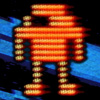 The use of 8 bit chiptune sounds has been extending beyond the insular video game world and into other genres.  Dusty old Nintendo consoles and Commodore 64 computers have been reprogrammed into musical instruments for years now, and there is an entire compilation album of artists using only the Game Boy based Nanoloop software.  Return of the Bloop Beep Buzz pushes this concept even further, using the even more primitive Atari 2600 as its primary source, resulting in a limited, but still unique sonic palette.
The use of 8 bit chiptune sounds has been extending beyond the insular video game world and into other genres.  Dusty old Nintendo consoles and Commodore 64 computers have been reprogrammed into musical instruments for years now, and there is an entire compilation album of artists using only the Game Boy based Nanoloop software.  Return of the Bloop Beep Buzz pushes this concept even further, using the even more primitive Atari 2600 as its primary source, resulting in a limited, but still unique sonic palette.
While the venerable 2600 isn't the most primitive of video game technology, it certainly is close, producing limited graphics and even more limited sounds.Mike Bourque sticks mostly to just the stock system, throwing in processing via the occasional guitar pedal, but never enough to obscure the underlying sounds.
Tracks like "Xenotropolis" and "Red Dragon vs. Square Dude" shape the white noise blasts into a rudimentary drum machine, pushing out a gabber-type throb over bassy abstract loops and Pac-Man like melodic outbursts.Hints of some of the earliest Digital Hardcore releases pop up, but the sound is completely unique.
"Interlocking Secrets" and "Full Attack Mode" also keep a rhythmic structure to them, but it's less of a focus, and more about obtuse loops and dissonant electronics."Wave 44" also is as conceptual as it is rhythmic, building from a dramatically thin, brittle rhythm in to a slightly thicker, but still heavily filtered ending.
The early-Autechre like glitchy crunch of "Dr. Mindbender in the Lab" and technoid thump of "Jammas on the Amazon" round out the multifaceted beat-centric tracks, but there’s also a few abstract, ambient-heavy moments scattered throughout.The textural, amorphous "Xenotropolis" leans into ambient techno realms, but in anything but the conventional sense.
"The Zaxxonian Theory" also is arrhythmic, with outstretched passages of sound and less of a perceptible formal structure, similar to the closer "Into the Darkness we Goeth".This track lets in a bit of industrial rhythmic thump, but ends in an over-driven, noise laden blast, perhaps taking the sound the furthest from its simplistic roots but never fully hiding where it came from.
I've always considered the "chiptune" scene more of a novelty than any meaningful music genre, and I’m probably the biggest video game fan on staff here at Brainwashed.However, this album goes beyond just novelty and is more of a study of limited instrumentation, reshaping the familiar lo-fi sounds into both beats and ambience.While the reliance on a singular source cuts the track-to-track diversity down a bit, the variation in structures covers for it nicely.Surely gamers will get more out of the disc than others, but its appeal wouldn't be limited to just that group.
samples:
 
Read More

